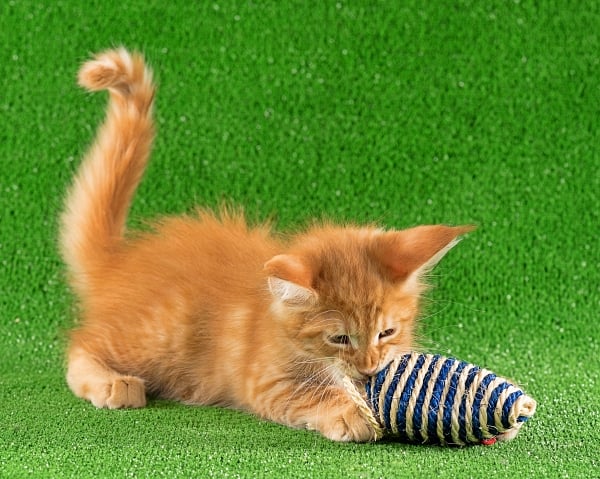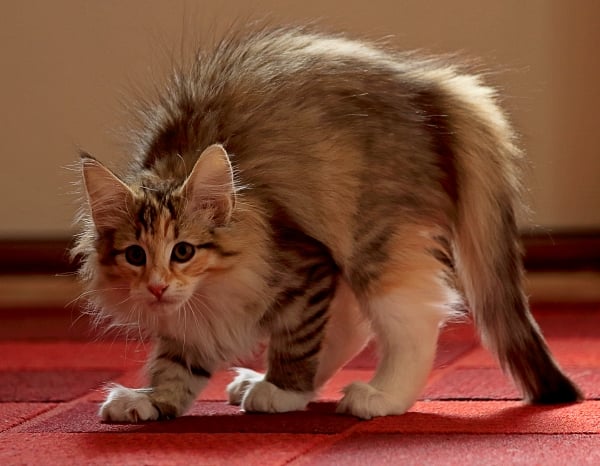Does your cat have a puffy tail? We are often asked in our clinic about this behavior by new pet parents. Have you ever noticed that when something startles your cat, their tail becomes big and puffy? Usually, it stays like this for several minutes, especially if your feline friend is frightened by a noise but they can’t tell what was the source of it was. In addition to the puffed up tail, their hair may be standing on their lower back. So, what’s going on? Why does your cat get a puffy tail?
In this article, you’ll learn how your cat’s tail puffs, why it does that, what it means, and the top 5 reasons for your cat’s puffy tail.

How does a cat’s tail puff up?
The reason is similar to why we cat owners get goosebumps. Goosebumps are small bumps on your skin that usually appear when you are cold, scared, or even emotional. They happen when tiny muscles contract in the hair follicles make the hair stand up. They make your skin look like that of a plucked goose, hence the name. In some places, it’s also called “chicken skin”. Your choice.
When your cat makes their fluffy tail puff up, the muscles at the base of their tail contracts. This causes the hair to contract which makes it stand on end, making the tail appear bigger and thicker. The hairs are also coated in a special substance that makes them stand up even more.
Bushy tails are simply erected hair, also called piloerection and serves several functions. For us, piloerection is just a remnant from our ancestors since we have very little hair on our skin. Well, most of us anyway. However, for cats and other animals, piloerection is a big deal.
One thing to note, a short haired cat’s tail will be more noticeable than a long haired one. This is because the longer hair weighs more. Since the hairs are longer and heavier, they don’t stand up as easily as a shorter hairs.
Why does a cat’s tail puff out?
Cats puff their tails as a form of feline body language for a variety of reasons including:
- Fear: When your cat is scared, it may puff up its tail in an attempt to look bigger and more intimidating. This is a natural response that helps your cat to deter predators.
- Excitement: A puffy tail can also be a sign of excitement or playfulness. If a cat is feeling happy and playful, it may wag its tail vigorously, causing the hairs on the tail to stand on end.
- Annoyance: A puffy tail can also be a sign of annoyance or irritation. If a cat is feeling annoyed by something, it may puff up its tail and twitch it back and forth.
- Health problems: In some cases, a puffy tail can be a sign of a health problem. If a cat’s tail is constantly puffed up, it may be a sign of allergies, pain, or another medical condition.
What does it mean when my cat puffs up their tail?
Cats use their tails for communication a lot, and in certain situations, it is a useful method of communication. The meaning of a puffy cat tail can vary depending on the context. If your cat is puffing up their tail in a fearful situation, it’s a response to hormone signals of their fight or flight reaction. However, if your cat is puffing up their tail in a playful situation, it is a sign that they are feeling happy and excited.
Here are some additional tips for understanding your cat’s tail language:
- The position of the tail: The position of the tail can tell you a lot about how your cat is feeling. For example, a cat that is holding its tail high and erect is feeling confident and assertive. A cat that is holding its tail low and tucked between its legs is feeling submissive or scared.
- The movement of the tail: The movement of the tail can also be a clue to your cat’s mood. For example, a cat that is wagging its tail slowly is feeling relaxed and content. A cat that is wagging its tail rapidly is feeling excited or playful.
- The fur on the tail: The fur on the tail can also give you some clues about your cat’s mood. For example, a cat that has its fur standing on end is feeling threatened or scared. A cat that has its fur relaxed is feeling calm and relaxed.
By paying attention to your cat’s tail language, you can learn a lot about how they are feeling and what they are trying to tell you. This can help you to build a stronger relationship with your cat so you can understand their needs better.
Is there a way to determine why my cat’s tail puffed up?
There are a few things you can look for to help you determine why your cat’s tail puffed up. These include:
- Your cat’s body language: If your cat is also growling, hissing, or flattening their ears, they are likely feeling threatened. This is known as defensive aggression.
- The environment: If there is a loud noise or a stranger in the room, your cat may be puffing up their tail out of fear.
- Your cat’s history: If your cat has a history of being abused or neglected, they may be more likely to puff up their tail in fear.
In addition to the things listed above, there are a few other signs you should look for if you think your cat’s tail is puffed up for a reason other than fear. These include:
- A change in your cat’s behavior: If your cat is suddenly more aggressive or withdrawn, it may be a sign of a health problem.
- A change in your cat’s appearance: If your cat’s tail is constantly puffed up or if the hairs on their tail are falling out, it may be also be a sign of a health problem.
Top 5 Reasons Why Cats Puff Their Tails

Cat tail language is used in a variety of situations. These are the top 5 reasons why:
1. Fear
As mentioned above, cats may puff their tails as a defense mechanism. This is an instinctive response that helps them to appear bigger and more intimidating to potential predators. If your cat is puffing up their tail and showing other signs of fear, such as growling, hissing, or flattening the ears, it is important to remove them from the situation that is making them feel threatened.
2. Aggressive
Cats may also puff their tails when they are feeling aggressive. This is often accompanied by other aggressive body language that they are in offensive mode. This can include growling, hissing, and flattening their ears. If your cat is puffing up their tail and showing other signs of aggression, it is important to avoid interacting with them and to give them some space.
3. Playtime
In some cases, cats may puff their tails when they are playing. This is often accompanied by other playful body language, such as wagging their tail and chasing toys. If your cat is puffing up their tail and showing other signs of playfulness, it is safe to interact with them and to join in on the fun.
4. Submissive
Cats may also puff their tails when they are feeling submissive. This is often accompanied by other submissive body language, such as flattening the ears and tucking their tail between the legs. If your cat is puffing up their tail and showing other signs of submission, it is important to be gentle with them and to avoid making them feel threatened.
5. Defensive
Cats may also puff their tails when they are feeling defensive. This is often accompanied by other defensive body language, such as arching the back and raising the fur on the back of the neck. If your cat is puffing up their tail and showing other signs of defense, it is important to avoid interacting with them and to give them some space.
How to Tell What a Puffed-Up Tail Means
As you can see, there are a variety of reasons why a cat’s tail might puff up. The best way to determine the meaning of a puffy tail is to consider the context in which it occurs. If your cat is puffing up their tail in a fearful situation, it is a sign that they are feeling threatened. However, if your cat is puffing up their tail in a playful situation, it is a sign that they are feeling happy and excited.
More details
In addition to the reasons listed above, there are a few other things that can cause a cat’s tail to puff up. These include:
- Stress: If a cat is feeling stressed, it may puff up its tail as a way to cope with the stress.
- Socialization: If a cat is not well-socialized, it may puff up its tail when it is around other animals or people.
- Breed: Some cat breeds, such as the Maine Coon, are more likely to puff up their tails than others.
If you are concerned about your cat’s tail, it’s always best to consult with your veterinarian. They can help to determine the cause of the puffiness and recommend a course of treatment if necessary.
Conclusion
A puffy cat tail can be a sign of a variety of things, both positive and negative. It is important to pay attention to your cat’s body language and context to determine what the puffy tail means in a particular situation. If you are ever concerned about your cat’s tail, it is always best to consult with a veterinarian.
You’ve learned how your cat’s tail puffs, why it does that, what it means, and the top 5 reasons for your cat’s puffy tail. This will go a long way towards building a strong, healthy, and happy relationship with your pet cat. And keeping your Pet Happy is what we all want.
FAQ
Question: How do I determine why my cat’s tail puffed up?
Answer: You can determine why your cat’s tail puffed up by observing their body language, their environment, and their history.
Question: What are the top 5 reasons why cats puff their tails?
Answer: Cats puff their tails due to fear, aggression, playfulness, submission, and defensiveness.
Question: How do I tell what a puffed-up tail means?
Answer: To determine the meaning of a puffed-up tail, consider the context in which it occurs. Fearful situations indicate threat, while playful situations show happiness.
Question: What else can cause a cat’s tail to puff up?
Answer: Other factors like stress, socialization, and certain cat breeds may cause a cat’s tail to puff up.
Question: Should I be concerned about my cat’s puffy tail?
Answer: It’s important to pay attention to your cat’s body language and consult with a veterinarian if you’re concerned about your cat’s puffy tail.
Question: How can understanding my cat’s tail language help our relationship?
Answer: Understanding your cat’s tail language allows you to better meet their needs and build a stronger relationship with them.
